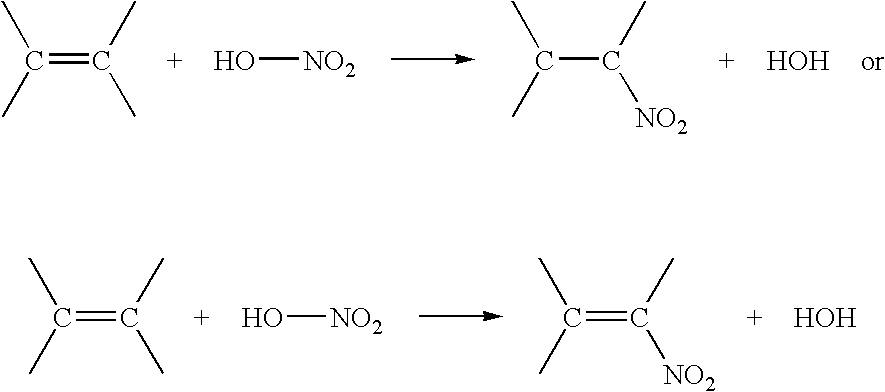Nitrated extreme pressure additives and blends
a technology of additives and additive blends, which is applied in the direction of organic chemistry, lubricant compositions, fuels, etc., can solve the problems of not being effective extreme-pressure additives, each of the above-mentioned commercial extreme-pressure additives has its own set of limitations, and is not suitable for use in internal combustion engine applications or other corrosion-sensitive applications
- Summary
- Abstract
- Description
- Claims
- Application Information
AI Technical Summary
Problems solved by technology
Method used
Image
Examples
example # 1
Example #1
Nitrated Soybean Oil
[0035]To a three-necked round bottom flask, equipped with a thermometer, stirring bar, Dean-Stark trap, gas sparger, and a condenser, 89.0 g (0.100 mole) of refined soybean oil and 16.1 g (0.179 mole) of 70% nitric acid were charged. The batch was heated to and maintained at 25-140° C., preferably at 60-120° C., more preferably at 70° C. for eight hours. Subsequently the temperature of the reaction was slowly increased to 100° C. The batch was maintained at 100° C. for two hours before cooling to 80° C. The batch was air-blown to remove essentially all entrapped water. A total of 8.0 g water was collected. The total weight loss was 8.7 g or 54% based on the weight of the nitric acid charge. The final yield was 96.5 g of dark brown fluid which FTIR at 1551-1554 cm−1 indicated contained the nitro group (C—NO2). The total nitric acid charge amounted to 18% by the weight of the starting organic.
example # 2
Example #2
Nitrated Soybean Oil
[0036]To a three-necked round bottom flask, equipped with a thermometer, stirring bar, Dean-Stark trap, gas sparger, and a condenser, 50.0 g (0.056 mole) of refined soybean oil and 13.2 g (0.147 mole) of 70% nitric acid were charged. The batch was heated to and maintained at 70° C. for eight hours. Subsequently the temperature of the reaction was slowly increased to 100° C. The batch was maintained at 100° C. for two hours before cooling to 80° C. Finally, the batch was air-blown or vacuum applied to remove essentially all entrapped water. A total of 6.6 g water was collected. The total weight loss was 11.4 g or 57% based on the weight of the nitric acid charge. The final yield was 55.6 g of dark brown fluid which FTIR at 1551-1554 cm−1 indicated contained the nitro group (C—NO2). The total nitric acid charge amounted to 26% by the weight of the starting organic.
example # 3
Example #3
Nitrated Soybean Oil
[0037]To a three-necked round bottom flask, equipped with a thermometer, stirring bar, Dean-Stark trap, gas sparger, and a condenser, 50.0 g (0.056 mole) of refined soybean oil and 20.0 g (0.222 mole) of 70% nitric acid were charged. The batch was heated to and maintained at 70° C. for eight hours. Subsequently, the temperature of the reaction was slowly increased to 100° C. The batch was maintained at 100° C. for two hours before cooling to 80° C. The batch was air-blown or vacuum applied to remove essentially all entrapped water. A total of 10.0 g water was collected. The total weight loss was 11.4 g or 57% based on the weight of the nitric acid charge. The final yield was 58.6 g of dark brown fluid which FTIR at 1551-1554 cm−1 indicated contained the nitro group (C—NO2). The total nitric acid charge amounted to 40% by the weight of the starting organic.
PUM
| Property | Measurement | Unit |
|---|---|---|
| temperature | aaaaa | aaaaa |
| temperature | aaaaa | aaaaa |
| temperature | aaaaa | aaaaa |
Abstract
Description
Claims
Application Information
 Login to View More
Login to View More - R&D
- Intellectual Property
- Life Sciences
- Materials
- Tech Scout
- Unparalleled Data Quality
- Higher Quality Content
- 60% Fewer Hallucinations
Browse by: Latest US Patents, China's latest patents, Technical Efficacy Thesaurus, Application Domain, Technology Topic, Popular Technical Reports.
© 2025 PatSnap. All rights reserved.Legal|Privacy policy|Modern Slavery Act Transparency Statement|Sitemap|About US| Contact US: help@patsnap.com

